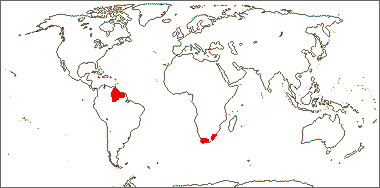Family name: Thurniaceae A. Engler
Synonym(s): Prioniaceae S. L. Munro & H. P. Linder
Common name(s): thurnia family
*Number of genera/species: 2/4
List of genera records in GRIN-Global
seed
Fruit a loculicidalloculicidal:
type of capsular dehiscence, opening longitudinally through the locules (compare septicidal)
 capsulecapsule:
capsulecapsule:
a dry, dehiscent fruit derived from a compound ovary , 1–15 mm long, triangulartriangular:
, 1–15 mm long, triangulartriangular:
2D shape—three relatively straight sides with distinct corners; more angular than teardrop-shaped , angledangular:
, angledangular:
2D shape—having sides that meet at acute or obtuse angles
in transection, usually 3 seeded, sometimes hypanthium present. Pericarppericarp:
fruit wall or fruit coat
smooth.
Seeds fusiformfusiform:
spindle-shaped; broadest at the middle and tapering at both ends (ovateovate:
(ovateovate:
2D shape—egg-shaped in outline, widest point is towards one end of the organ, the other end tapers gradually, attachment at or near the broad end (compare obovate, ovoid) to broadly ovateovate:
to broadly ovateovate:
2D shape—egg-shaped in outline, widest point is towards one end of the organ, the other end tapers gradually, attachment at or near the broad end (compare obovate, ovoid) in Prionium), tereteterete:
in Prionium), tereteterete:
approximately circular in cross section; width and thickness approximately equal
 (triagonal in Prionium) in transection, 5–8 mm long, hairlike appendages present at both ends (not appendiculate in Prionium). Seed coat with short, straight hairs (glabrousglabrous:
(triagonal in Prionium) in transection, 5–8 mm long, hairlike appendages present at both ends (not appendiculate in Prionium). Seed coat with short, straight hairs (glabrousglabrous:
without hairs
in Prionium).
Embryo well developed, linearlinear:
(shape) long, narrow, and uniform in width; (of embryo) embryo is straight and much longer than wide to broad, straight, 0.3 times the length of the endosperm (or nearly as long in Prionium).
to broad, straight, 0.3 times the length of the endosperm (or nearly as long in Prionium).
Endosperm copious, mealymealy:
loose, dry, and disintegrating in finely granular
pieces like meal or flour
.
| Fruit | |
| Type | capsulecapsule: a dry, dehiscent fruit derived from a compound ovary  |
| Size range | 10–15 mm long |
| Shape(s) | tri angularangular: 2D shape—having sides that meet at acute or obtuse angles |
| Surface relief | smooth |
| Seed | |
| Size range | 5–8 mm long |
| Shape(s) | fusiformfusiform: spindle-shaped; broadest at the middle and tapering at both ends  , ovateovate: , ovateovate:2D shape—egg-shaped in outline, widest point is towards one end of the organ, the other end tapers gradually, attachment at or near the broad end (compare obovate, ovoid)  to broadly ovateovate: to broadly ovateovate:2D shape—egg-shaped in outline, widest point is towards one end of the organ, the other end tapers gradually, attachment at or near the broad end (compare obovate, ovoid)  |
| Surface relief | densely pubescentpubescent: surface relief—bearing hairs , glabrousglabrous: without hairs |
| Unique features | In Thurnia, seeds fusiformfusiform: spindle-shaped; broadest at the middle and tapering at both ends  and pubescentpubescent: and pubescentpubescent:surface relief—bearing hairs with hairlike appendages at both ends. In Prionium, seeds ovateovate: 2D shape—egg-shaped in outline, widest point is towards one end of the organ, the other end tapers gradually, attachment at or near the broad end (compare obovate, ovoid)  to broadly ovateovate: to broadly ovateovate:2D shape—egg-shaped in outline, widest point is towards one end of the organ, the other end tapers gradually, attachment at or near the broad end (compare obovate, ovoid)  and triagonal in transection. and triagonal in transection. |
| Other | |
| Embryo | well developed, linearlinear: (shape) long, narrow, and uniform in width; (of embryo) embryo is straight and much longer than wide  to broad, straight, 0.3 times the length of the endosperm (or nearly as long in Prionium) to broad, straight, 0.3 times the length of the endosperm (or nearly as long in Prionium) |
| Nutritive tissue | endosperm copious, mealymealy: loose, dry, and disintegrating in finely granular pieces like meal or flour |
Tropical South America.

Distribution map courtesy of Angiosperm Phylogeny Website.
Baskin and Baskin 2021Baskin and Baskin 2021:
Baskin C and Baskin J. 2021. Relationship of the lateral embryo (in grasses) to other monocot embryos: A status up-grade. Seed Science Research 31 (3): 199-210. doi:10.1017/S0960258521000209; Dahlgren et al. 1985Dahlgren et al. 1985:
Dahlgren RMT, Clifford HT, and Yeo PF. 1985. The families of the monocotyledons: structure, evolution, and taxonomy. Springer-Verlag, Berlin. 520 pp.; Kirkbride et al. 2006Kirkbride et al. 2006:
Kirkbride JH, Jr, Gunn CR, and Dallwitz MJ. 2006. Family guide for fruits and seeds, vers. 1.0. Accessed September 2020-January 2022. URL: https://nt.ars-grin.gov/seedsfruits/keys/frsdfam/index.cfm .; Kubitzki et al. 1990+Kubitzki et al. 1990+:
Kubitzki K et al., eds. 1990+. The families and genera of vascular plants. 7+ vols. Berlin etc.; Maas and Maas 2005Maas and Maas 2005:
Maas PJM and Maas H. 2005. Flora Da Reserva Ducke, Amazonas, Brasil: Thurniaceae. Rodrigueacute;sia 56: 207.; Stevenson and Loconte 1995Stevenson and Loconte 1995:
Stevenson DW and Loconte H. 1995. A cladistic analysis of monocot families. In: Rudall PJ, Cribb PJ, Cutler DF, and Humphries CJ, eds. Monocotyledons: Systematics and Evolution. Royal Botanic Gardens, Kew.
*The number of genera and species is based on Christenhusz and Byng 2016Christenhusz and Byng 2016:
Christenhusz MJM and Byng JW. 2016. The number of known plant species in the world and its annual increase. Phytotaxa 261 (3): 201-217. https://doi.org/10.11646/phytotaxa.261.3.1, which may differ from the number of genera in GRIN-Global.